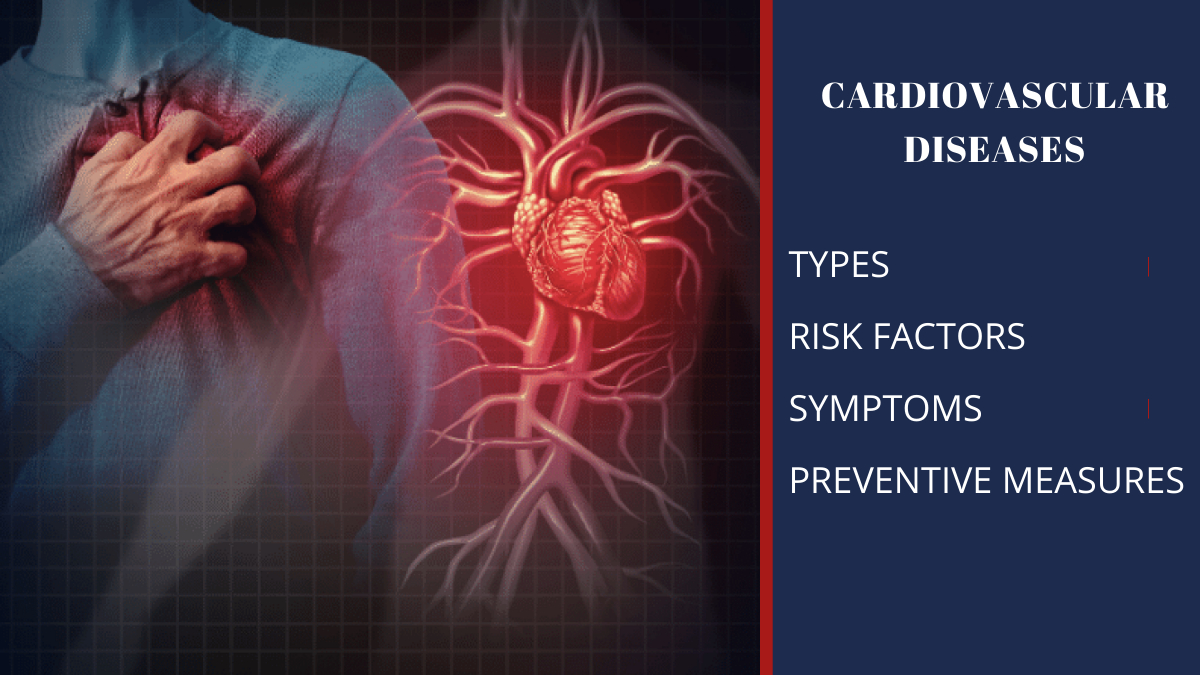Cardiovascular disease is a term used to describe any type of heart or blood vessel-related illness. The word ‘cardiovascular’ literally means ‘relating to the heart and blood vessels’, so, any disease that is related to the heart or blood vessels can be considered as cardiovascular.
Cardiovascular disease is the prime cause of death and disability in the world. Cardiovascular diseases are responsible for over 17 million deaths each year around the world. Cardiovascular disease can be Symptomatic or Asymptomatic.
Cardiovascular diseases can be caused by a range of factors including unhealthy life style, smoking, high cholesterol levels, high blood pressure, obesity, diabetes, lack of exercise and genetics.
It’s important to notice cardiovascular disease early on, so that the required treatment and management can begin.
TYPES OF CARDIOVASCULAR DISEASES:
There are a range of cardiovascular diseases which involves heart:
CORONARY ARTERY DISEASE:
Coronary artery disease, also known as coronary heart disease, is a condition in which the coronary arteries become narrowed and blocked. Coronary artery disease is caused by atherosclerosis, in which plaque builds up inside the artery walls. When the blood supply is cut off (due to a blockage), it can lead to angina or a heart attack.
ANGINA:
Angina is chest pain felt when the heart muscle doesn’t have enough oxygen. Angina is typically treated with nitrates, but sometimes a patient may need surgery or other treatments. The symptoms of angina include: chest pain, pressure, or heaviness, Palpitations, Shortness of breath, Dizziness, Nausea and vomiting .Chest pain radiating to the arm, neck, jaw, or stomach. Pain in one or both arms, neck or jaw Chest pain when you take a deep breath. It is often mistaken for anxiety. Weakness or numbness of an arm and leg on one side of your body. Sudden shortness of breath during exercise or with minimal exertion.
CARDIOMYOPATHY:
Cardiomyopathy is a condition in which the heart muscle has become weaker or stretched out. The main symptom is shortness of breath, and there may be other symptoms such as chest pain and fatigue.
Cardiomyopathy is a disease that makes it more difficult for the heart to pump blood to the rest of your body. This can lead to heart failure.
HEART ATTACK:
Heart attack is a life-threatening medical condition in which the blood flow to the heart is significantly reduced, resulting in chest pain and shortness of breath. It affects both men and women of all ages and can be caused by coronary artery disease or other heart diseases.
HYPERTENSIVE HEART DISEASE:
Hypertensive heart disease is a condition in which the pressure of the blood that flows through the veins is high. This high pressure can cause different symptoms, such as chest pain, headache, dizziness and fainting. Those who experience these symptoms should make an appointment with their doctor to find out more about hypertensive heart disease.
CARDIAC DYSRHYTHMIAS:
Cardiac dysrhythmias are a type of abnormal heartbeat. They can vary in severity, but they all interfere with the heart’s ability to pump blood and can be life-threatening.
HEART FAILURE:
Heart failure is a condition in which the heart does not pump enough blood to meet the body’s metabolic needs. Symptoms may include shortness of breath, tiredness, swelling and excessive sweating.
CONGENITAL HEART DISEASE:
Congenital heart disease is a birth defect of the heart’s structure. The most common type of congenital heart disease is Tetralogy of Fallot.
PULMONARY HEART DISEASE:
Pulmonary heart disease is a condition that has to do with the structure of the heart. The right side of the heart is affected, which means that it can’t pump blood efficiently. There are two types of Pulmonary Heart Disease: Primary and Secondary. Primary Pulmonary Heart Disease is caused by other conditions such as emphysema or bronchitis, while Secondary Pulmonary Heart Disease is caused by an underlying heart condition that leads to the development of pulmonary hypertension.
Pulmonary Hypertension: Pulmonary hypertension is a condition in which your arteries fail to properly open and allow blood flow into the lungs. This can lead to a build-up of pressure in your lungs (pulmonary edema) and, ultimately, an increased risk for heart failure or death.
INFLAMMATORY HEART DISEASE:
Inflammatory heart disease is a heart problem where inflammation is causing your artery walls to narrow, making it difficult for blood to flow through the body.
ENDOCARDITIS:
Endocarditis is a heart inflammation that affects the endocardium, which is the lining of the heart. Endocarditis is a complication associated with bacterial infections that affect the heart. This can happen when bacteria in the blood stream enters the bloodstream, and then gets inside the heart. The infection can grow and spread on the tissue of your heart’s valves and cause different symptoms including fever, shortness of breath, fatigue and rapid heartbeat.
INFLAMMATORY CARDIOMEGALY:
Inflammatory cardiomegaly, also known as peripartum cardiomyopathy, is a condition of enlarged heart where weakening of the heart muscle occurs in some women during pregnancy or within six months after giving birth.
MYOCARDITIS:
Myocarditis is the inflammation of the myocardium. It is a result of an infection such as diphtheria or Coxsackie virus and is typically associated with influenza or other respiratory infections.
EOSINOPHILIC MYOCARDITIS:
Eosinophilic myocarditis is a rare disease that affects the myocardium tissue of the heart by eosinophilic leukocytes.
VALVULAR HEART DISEASE:
Valvular heart disease is a condition of cardiovascular disease where the four valves of the heart involves. The aortic and mitral valves are present on the left side of the heart and the pulmonic and tricuspid valves on the right side of the heart).The functionality of the valves diminishes which in turn affects the heart function.
RHEUMATIC HEART DISEASE:
Rheumatic heart disease is a condition where a gram positive Streptococcus species – streptococcus pyogenes is responsible for rheumatic fever which damages the muscles and valves of the heart.
RADIATION HEART DISEASE:
In radiation heart disease, the radiations to the chest damages the valves and blood vessels of the heart.
Cardiovascular diseases which involves blood vessels (Vascular diseases):
CORONARY ARTERY DISEASE:
Coronary artery disease or ischemic heart disease is a condition in which the flow of blood to the muscles of the heart reduces because of the formation of atherosclerotic plaque in the arteries.
PERIPHERAL ARTERIAL DISEASE:
Peripheral arterial disease is narrowing of arteries thus reducing blood flow to arms and legs.
CEREBROVASCULAR DISEASE:
Cerebro vascular disease is a condition in which abnormal narrowing of the arteries takes place in the brain and cerebral circulation and thus decreasing the supply of oxygen and nutrients to the brain. Ischemic stroke is the most common cerebrovascular disease.
RENAL ARTERY STENOSIS:
Renal artery stenosis is the condition in which one or both renal arteries narrows mostly due to atherosclerosis which affects the blood flow to the aimed kidney leading to renovascular hypertension.
AORTIC ANEURYSM:
Aneurysm is enlargement of aorta that can bleed when ruptured.
ATHEROSCLEROSIS:
The formation of plaque around the walls of the blood vessels takes place making them narrow thus reducing the supply of oxygen.
DEEP VEIN THROMBOSIS (DVT):
Deep vein thrombosis is a condition in which there will be a blockage or plaque in blood vessels and veins that brings blood back from body, brain to heart.
RISK FACTORS FOR CARDIOVASCULAR DISEASE:
The precise cause for cardio vascular disease is not clear and vary according to the type of the disease for instance – atherosclerosis may be a reason for coronary artery disease, genetic or medications may be a reason for arrhythmias and infections, aging may be a cause for valvular diseases. But there may be many underlying determining factors that may increase or elevate the risk of the disease.
These factors are called “Risk factors”. The greater chances of getting cardio vascular diseases, if you have more risk factors. The factors include:
- Medical diagnoses:
Medical conditions like High blood pressure (hypertension), High cholesterol (hyperlipidemia), diabetes (high blood sugar), Gestational diabetes (pregnancy induced diabetes), excess weight or obesity, Preeclampsia (high blood pressure during pregnancy) or toxemia, chronic inflammatory or autoimmune conditions, chronic kidney disease may increase the chances of developing cardiovascular disease.
- Lack of physical activity:
Lack of physical activity may be one of the most important risk factors in developing cardio vascular diseases. The risk of heart diseases may be reduced by involving any type of physical activity. Exercising and any type of physical activity can help you keep your heart healthy. In addition exercise can also help in improving blood glucose, lipid profile, hypertension, Insulin sensitivity, maintaining healthy weight. These in turn lowers the chances of developing cardiovascular disease.
- Diet:
Diet plays an important role in the overall wellbeing of a person. Taking balanced healthy diet have a great impact on blood sugars, lipids, body weight and even blood pressure. Including more of saturated fats, Tran’s fats, salt, sugars, processed foods, energy foods have adverse effects on blood lipids and blood glucose which effects your heart health. Eliminating and minimizing these foods and including more of fruits and vegetables, fiber, grains can lower the risk of cardiovascular disease.
- Smoking And Alcohol:
High levels of alcohol consumption is directly related to high risk of cardiovascular disease. Smoking and other tobacco products can increase the risk for cardiovascular disease. High Alcohol consumption can increase blood pressure, cholesterol and tobacco intake can damage and narrow the blood vessels.
- Family History / Genetics:
Family history or genetics is an important risk factor. If you have a history of cardiovascular disease in your family then you are more likely at a risk of developing the disease. There is an increase by three fold if the family have the history of cardiovascular disease.
Other Risk Factors Include
- Age
- Gender
- Occupational Exposure
- Stress (traumatic and mental stress)
- Chemical and radiation exposure
- Sleep
Symptoms of Cardiovascular Disease:
Symptoms of heart attack:
Discomfort or pain in the chest region alone or along with pain in arms, left shoulder, or back. Sometimes shortness of breath or difficulty breathing can also be seen. Other symptoms like nausea or vomiting, headache, sweating or dizziness.
Symptoms of a stroke:
Weakness in the face region, arm or leg or sometimes total one side of the body can be seen.
Numbness, confusion, blurred vision, difficulty in speaking or understanding, walking, loss of coordination, headache or fainting are the other symptoms.
Symptoms of blood vessels when there is a blockage:
More often, the symptoms are asymptomatic with blood vessel disease but some symptoms include cramps or pain in legs while walking, appearance of red skin on legs, swelling in legs, coordination imbalance, numbness especially one side of the body.
Symptoms of rheumatic disease:
Shortness of breath or difficulty breathing, giddiness, fatigue, irregular heartbeats, chest pain and fainting are the symptoms of rheumatic heart disease.
Fever, swelling and pain of the joints, nausea sensation or vomiting, stomach cramps are the symptoms of rheumatic fever.
Preventive Measures:
Cardiovascular disease can be preventable if appropriate measures taken for established risk factors. Life style changes can greatly reduce the risk of developing many cardiovascular diseases expect which cannot be prevented like congenital heart disease. Preventing measures may be varying depending upon the condition and risk factors involved.
You can minimize the risk of developing cardiovascular disease by the following measures:
Diet:
Eat a balanced diet .Include a variety of food in your menu. Diet should be balanced and nutritious. Include more of fruits and vegetables, whole grains, fiber, dark colored foods, good fats, functional foods (foods rich in antioxidants, phytochemicals and micro nutrients), adequate fluids.
Minimize or restrict or avoid unhealthy foods like foods containing high amounts of simple sugars, saturated fats, Tran’s fats, and salt, processed, preserved and canned foods and empty calorie drinks, carbonated and caffeinated beverages.
Diet including high portions of fruits and vegetables reduces the chances of cardiovascular disease.
Physical Activity:
Regular physical activity can have great impact on cardiac health along with overall health and fitness. Physical Mobility or exercise reduces the chances of cardiovascular diseases. Minimum of 45mins to 1 hour physical activity is recommended to acquire good results.
Quit smoking:
Quit smoking and avoid second hand smoke which reduces the risk of cardiovascular disease by 35%.
Limit alcohol intake:
Reduce or avoid alcohol consumption. Excessive consumption of alcohol can increase the risk of developing cardiovascular diseases.
Enough sleep:
Insufficient sleep can adversely affect the overall health. Decreased sleep quota can increase the risk of hypertension and sleep apnea may increase the risk of heart disease. Minimum of 6-8 hours’ sleep per day is recommended.
Good Mental Health:
Stress, depression and bad mental health are associated with increased chances of heart problems. Practice relaxation techniques to stay calm.
Manage other medical conditions:
Overweight, diabetes, hypertension, hyperlipidemia, renal diseases are the diseases which affects the cardiovascular diseases. It’s important to manage them under control is very much needed. Healthy diet (low in saturated fats, salt, and sugars), physical activity and medication can help in managing these health conditions.
BOTTOM LINE – Cardiovascular disease
Cardiovascular disease is the type of condition in which the heart and its blood vessels gets affected. There are many types of cardiovascular diseases depending on the parts affected. Many risk factors are associated in developing cardiovascular diseases.
Early diagnosis, managing other health conditions, life style changes, diet, physical activity and proper medication can help in managing cardiovascular disease.
Staying healthy can minimize the risk of getting worse and living a full and active happy life.




Great post.